混凝土基本概念 专业英语
混凝土和易性名词解释

混凝土和易性名词解释混凝土(Concrete)是一种由水泥、砂、石料和水按一定比例配制而成的人工石材。
混凝土在建筑、水利、交通、市政等领域得到广泛应用,是最重要的建筑材料之一。
以下是混凝土及与其相关的易性名词的解释。
1. 强度(Strength):混凝土的抗压强度是评估其质量和耐久性的重要指标之一。
强度越高,混凝土的负荷承载能力越强。
2. 塑性(Plasticity):混凝土在未硬化之前具有一定的塑性,可以通过可塑性、可流动性的状态塑造成各种形状。
3. 流动性(Workability):混凝土的流动性是指混凝土在施工过程中易于流动和填充各种细小空隙的性质。
良好的流动性有利于提高混凝土的紧密性和强度。
4. 凝结(Setting):混凝土在水泥与水发生反应形成水化产物的过程。
凝结过程可分为凝结初期、凝结中期和凝结后期。
5. 初凝时间(Initial setting time):混凝土开始凝结的时间。
初凝时间长短直接关系到施工的进展。
6. 终凝时间(Final setting time):混凝土完全凝结的时间。
终凝时间长短与混凝土的硬化过程和强度发展有关。
7. 塌落度(Slump):塌落度用来评估混凝土的流动性,是指在试验条件下混凝土塔型坍塌的高度。
塌落度的大小直接影响着施工的操作性和混凝土的质量。
8. 胶体颗粒(Colloidal particles):混凝土中的胶体颗粒是指颗粒大小在1nm至1μm的微细固体颗粒。
胶体颗粒对混凝土的流动性和强度发展有重要影响。
9. 质量控制(Quality control):混凝土生产过程中的质量控制是通过控制原材料的配比、质量和施工工艺的要求,以确保混凝土的性能达到设计要求。
10. 龄期(Age):指混凝土的硬化时间,随着时间的推移,混凝土会逐渐增强。
混凝土是一种广泛应用于建筑、桥梁、水利、公路等工程领域的材料,了解混凝土的基本概念和易性名词对于设计、施工和维护工作具有重要意义。
混凝土的英文单词

混凝土的英文单词
Concrete作为名词,是混凝土,所以也就有了使物体成型的意思
词义可以解读为:混凝土制的;确实的;具体的,可以搭配使用
concreteplan/evidence/proposals/proof 来表示具体的计划;确凿的证据;具体的建议;确实的证明。
例句:
1、It's not set in concrete and I am in the process of building the project plan for this so that we can look at all concerns, challenges and logistical nightmares!
它还没有确定下来,我正在为此制定项目计划,这样我们就可以看到所有的问题、挑战和后勤噩梦!
2、The statue rests on a bed of concrete.
这座雕像立在混凝土的基座上。
3、The road was paved with concrete.
路面由混凝土铺成。
4、It is easier to think in concrete terms rather than in the abstract.
结合具体的事物来思考要比抽象思考容易些。
其他可作为混泥土英文使用的替代词:
但在由于水泥通常用来制作混凝土(concrete),于是在生活中人们往往很容易将其与concrete 相混淆,比如水泥地(a cement floor)实际上是用混凝土铺设的地面,而并非单纯是用水泥铺设的。
久而久之,cement 也就多出来一个义项,指“干燥后硬化的水泥”,或者直接等同于concrete ,用来代指“混凝土”。
建筑施工名词中英文对照

建筑施工名词中英文对照建筑施工是一个复杂而细致的过程,其中涉及大量的专业名词。
对于从事建筑施工行业的人士来说,掌握这些名词的中英文对照是非常重要的。
本文将介绍一些常用的建筑施工名词的中英对照,帮助读者更好地理解和运用这些术语。
1. Foundation - 基础基础是建筑物最底部的结构,通常是混凝土的平面,用来支撑整个建筑物的重量。
2. Reinforced concrete - 钢筋混凝土钢筋混凝土是一种由混凝土和钢筋组成的材料,具有高强度和耐久性,广泛应用于建筑施工中。
3. Masonry - 砌体结构砌体结构是一种由砖块或石块按照一定的方式砌筑而成的结构,常用于建筑物的墙体和隔墙。
4. Column - 柱子柱子是一种纵向的结构元素,通常用于支撑建筑物的荷载,并传递到基础。
5. Beam - 梁梁是一种横向的结构元素,通常用于支撑楼板和屋顶,并将荷载传递到柱子上。
6. Slab - 板板是建筑物的水平支撑结构,通常用于构成楼板、屋顶和平台等。
7. Wall - 墙体墙体是建筑物的竖向结构,通常用于分隔空间并承受水平荷载。
8. Roof - 屋顶屋顶是建筑物的最顶部覆盖结构,用于保护建筑物免受自然环境的影响。
9. Foundation pit - 基坑基坑是在施工过程中挖掘的一个具有一定深度和形状的空间,用于建筑物的基础施工。
10. Excavation - 开挖开挖是指移除地表土壤或岩石以形成基坑或其它结构的过程。
11. Pile - 桩基桩基是在土壤或岩石中打入的长桩,用于增加地基的稳定性和承载能力。
12. Formwork - 模板模板是一种用于在混凝土浇筑过程中支撑和成型的结构,通常由木材或金属构造而成。
13. Rebar - 钢筋钢筋是一种用于增加混凝土结构强度的金属材料,通常以长条形式使用。
14. Concrete mixer - 混凝土搅拌机混凝土搅拌机是一种用于将水泥、沙子、石子和水混合制成混凝土的设备。
混凝土词源

混凝土词源词源解析:混凝土(concrete)1.单词的来历“concrete”这个词是土生土长的英语词汇哦。
它就像一个本土生长的踏实劳动者,一步一步发展至今。
它源于拉丁语“concretus”,意思是“生长在一起”,这个词带着一种融合、凝聚的原始概念来到了英语的世界里。
2.拆解单词“concrete”可以拆分为“con - ”和“crete”。
“con - ”这个前缀有“共同、一起”的意思,就像是小伙伴们手拉手。
而“crete”呢,它和“create”(创造)有点关联,有一种生成、制造的感觉。
合起来就像是许多东西共同创造、融合在一起,就像混凝土是由多种材料混合而成的一样,仿佛是一场神奇的材料聚会。
3.单词的演变史在历史的长河中,“concrete”从最初表示“生长在一起”这种比较抽象的概念,逐渐演变成专门指代一种建筑材料。
它从一种比较宽泛的凝聚、融合的概念,慢慢聚焦到由水泥、沙石等混合而成的坚硬物质。
就像是一个有很多技能的人,最后选择了建筑行业作为自己的专长,经过长时间的沉淀,成了如今建筑工程中不可或缺的重要角色。
4.有趣的背后故事据说在古代,人们就开始尝试将不同的材料混合起来以达到坚固的效果,虽然那时候还没有现代意义上的混凝土。
后来当混凝土被正式发明出来,它迅速改变了建筑的格局。
有个小趣闻是,罗马人建造的万神殿就使用了类似混凝土的材料,那时候的混凝土就像一个隐藏在建筑里的神秘力量,默默地支撑着伟大的建筑,而当时的人们可能还没意识到这个东西在未来会变得如此普及。
5.今天我们怎么用它在现代英语中,“concrete”主要就是指混凝土这种建筑材料啦。
比如我们会说“a concrete building”(一座混凝土建筑)或者“concrete pavement”(混凝土路面)。
和最初表示生长在一起的意义相比,确实是发生了很大的变化,现在它就是建筑界的“硬汉”,哪里需要坚固的支撑,哪里就有它的身影,就像我们生活中的默默守护者一样。
混凝土(concrete)

混凝土(concrete)混凝土(concrete)是由水泥、砂、骨料和水按照一定比例混合而成的人工建造材料。
作为最常见的建造材料之一,混凝土具有强度高、耐久性好、阻燃、隔热等特点。
本文将详细介绍混凝土的制作、性能及应用。
一、混凝土的制作1. 原材料准备- 水泥:根据混凝土的工程要求和性能需求选择合适的水泥品种。
- 砂:用于配制砂浆,常用的砂类有河沙、山砂等。
- 骨料:主要包括粗骨料和细骨料,常用的有碎石、砂石等。
- 水:选择清洁无杂质、符合规定要求的水。
2. 配制混凝土- 配置配合比:根据工程要求和混凝土性能需求确定合理的配合比。
- 搅拌混合:将水泥、砂、骨料和水按一定比例放入混凝土搅拌车或者混凝土搅拌站进行搅拌。
- 灌注浇筑:将搅拌好的混凝土倒入模具或者建造结构中进行浇注。
二、混凝土的性能1. 强度性能- 抗压强度:混凝土在受压作用下的反抗能力。
- 抗拉强度:混凝土在拉伸作用下的反抗能力。
- 抗折强度:混凝土在弯曲作用下的反抗能力。
2. 耐久性能- 抗渗透性:混凝土反抗液体、气体通过的能力。
- 抗冻融性:混凝土在冻融循环中的反抗能力。
- 抗硫酸盐侵蚀性:混凝土反抗硫酸盐侵蚀的能力。
3. 施工性能- 流动性:混凝土的可流动性和可塑性。
- 凝结时间:混凝土从浇筑到达给定的强度所需的时间。
- 收缩性:混凝土在硬化过程中发生的体积变化。
三、混凝土的应用1. 建造领域- 房屋建造:混凝土用于楼板、墙体、地基等建造构件。
- 桥梁建造:混凝土用于桥墩、桥台、桥面等建造构件。
- 隧道工程:混凝土用于隧道壁、顶板等建造构件。
2. 基础设施建设- 高速公路:混凝土用于路面、路基等建造构件。
- 水利工程:混凝土用于水坝、水渠、水塔等建造构件。
- 输电工程:混凝土用于电缆沟、电缆槽等建造构件。
3. 工业领域- 工业厂房:混凝土用于厂房地板、墙体等建造构件。
- 储存设备:混凝土用于仓库、库房等建造构件。
- 加工设备:混凝土用于机械基础、设备基座等建造构件。
混凝土的基础知识
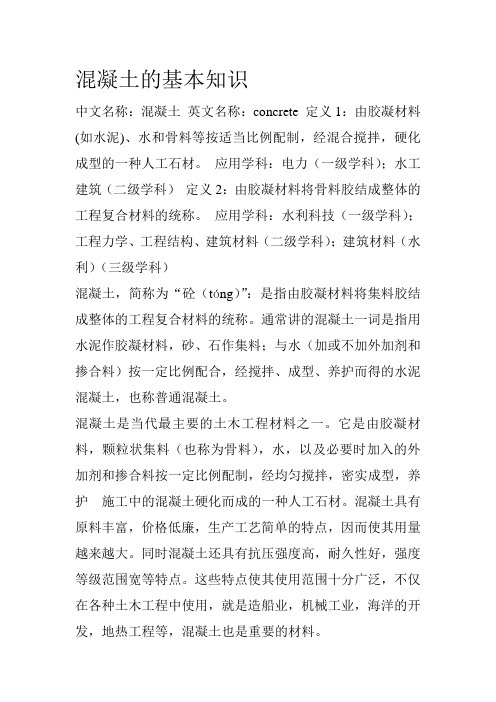
混凝土的基本知识中文名称:混凝土英文名称:concrete 定义1:由胶凝材料(如水泥)、水和骨料等按适当比例配制,经混合搅拌,硬化成型的一种人工石材。
应用学科:电力(一级学科);水工建筑(二级学科)定义2:由胶凝材料将骨料胶结成整体的工程复合材料的统称。
应用学科:水利科技(一级学科);工程力学、工程结构、建筑材料(二级学科);建筑材料(水利)(三级学科)混凝土,简称为“砼(tóng)”:是指由胶凝材料将集料胶结成整体的工程复合材料的统称。
通常讲的混凝土一词是指用水泥作胶凝材料,砂、石作集料;与水(加或不加外加剂和掺合料)按一定比例配合,经搅拌、成型、养护而得的水泥混凝土,也称普通混凝土。
混凝土是当代最主要的土木工程材料之一。
它是由胶凝材料,颗粒状集料(也称为骨料),水,以及必要时加入的外加剂和掺合料按一定比例配制,经均匀搅拌,密实成型,养护施工中的混凝土硬化而成的一种人工石材。
混凝土具有原料丰富,价格低廉,生产工艺简单的特点,因而使其用量越来越大。
同时混凝土还具有抗压强度高,耐久性好,强度等级范围宽等特点。
这些特点使其使用范围十分广泛,不仅在各种土木工程中使用,就是造船业,机械工业,海洋的开发,地热工程等,混凝土也是重要的材料。
历史1900年,万国博览会上展示了钢筋混凝土在很多方面的使用,在建材领域引起了一场革命。
法国工程师艾纳比克1867年在巴黎博览会上看到莫尼尔用铁丝网和混凝土制作的花盆、浴盆、和水箱后,受到启发,于是设法把这种材料应用于房屋建筑上。
1879年,他开始制造钢筋混凝土楼板,以后发展为整套建筑使用由钢筋箍和纵向杆加固的混凝土结构梁。
仅几年后,他在巴黎建造公寓大楼时采用了经过改善迄今仍普遍使用的钢筋混凝土主柱、横梁和楼板。
1884年德国建筑公司购买了莫尼尔的专利,进行了第一批钢筋混凝土的科学实验,研究了钢筋混凝土的强度、耐火能力。
钢筋与混凝土的粘结力。
1887年德国工程师科伦首先发表了钢筋混凝土的计算方法;英国人威尔森申请了钢筋混凝土板专利;美国人海厄特对混凝土横梁进行了实验。
混凝土基本原理词汇

------1-------Concrete structure 混凝土结构Reinforced Concrete structure 钢筋混凝土结构Plain Concrete structure 素混凝土结构Prestressed Concrete structure 预应力混凝土结构Fibre reinforced Concrete structure 纤维增强混凝土结构Rebar (reinforcement) 钢筋Compressive strength 抗压强度Tensile strength 抗拉强度Section 截面Crack 裂缝Stress 应力Strain 应变Beam 梁Bond 粘结Coefficient 系数Rust 生锈Brittle 脆性Ductility 延性Moldability 可焊接性Cast 浇注Strength-cost ratio 强价比Fire-resistance 抗火Wood structure 木结构Masonry structure 砌体结构Steel structure 刚结构Monolithic 整体性Self-weight 自重Span 跨度Light-weight 轻质的High-strength 高强的High-performance concrete 高性能混凝土Prefabrication 预制Plastic 塑性的Load-carrying capacity 承载能力Elastic 弹性的Multiaxial 多轴的scale effect 尺寸效应size effect尺寸效应bond 粘结slip 滑移deformation 变形code 规范adherence 粘结bond 粘结friction 摩擦shrinkage 收缩harden 硬化grip 握裹effect 效应expansion 膨胀water-cement ratio 水灰比matching 匹配impact/collision 冲击static 静力的dynamic 动力的linear 线性的nonlinear 非线性的dissipation 耗散isolation 孤立active control 主动控制torsional 扭的local damage 局部损坏collapse 失效,倒塌road curb walls 道路护栏bridge piers 桥墩dike 岸堤vibration 振动steel-encased concrete structure 钢骨混凝土结构concrete-infilled steel tube structures 钢管混凝土结构steel-concrete composite structuresflow property 流动性permeability 渗透性spray 喷射shear strength 抗剪强度rupture strength 抗弯强度fatigue 疲劳matrix 基体aseismic 抗震的frame 框架hydraulic 水力的synthetic fiber 人造纤维toughness 韧性alkaline 碱性的carbon fiber 碳纤维strengthening 加固member 构件solid web 实腹式open web 空腹式buckle 屈曲-------- 2---------Mechanical 力学的Physical 物理的Hardened cement 水泥石Cement mortar 水泥砂浆Coarse aggregates 粗骨料Base phase 基相Dispersed phase 分散相Dissociative water 游离水Capillary 毛细管Gel 凝胶Skeleton 骨架Unhydrated 未水化的Plastic rheological bodies 塑性流变体Cavity 洞、孔隙Microcrack 微裂缝Microstructure 微观结构Mesostructure 亚微观结构Macrostructure 宏观结构Uniaxial 单轴的Specimen 试件Reliability 可靠性size effect 尺寸效应The conversion coefficient 转换系数Prism棱柱Regression 回归分析Lateral 侧向的Additional eccentricity 附加偏心距Cylinder 圆柱体Instability 失稳Mechanism 机制Quasi-elastic 准弹性Stress concentration 应力集中Non-recoverable 不可恢复的Curve 曲线Critical stress临界应力Coalesce 结合Parallel 平行的Dilation 膨胀Disintegration 瓦解Splitting test 劈裂试验Local bearing strength 局部承载强度Triaxial 三向轴的Empirical 经验的Monotonic 单调的Inflection point 反弯点Convergence point 收敛点Elastic strain 弹性应变Plastic strain 塑性应变Viscous 粘性的The proportional limit 比例极限Helical stirrups 螺旋箍筋Square stirrups 方形箍筋Longitudinal rebars 纵向钢筋Pitch 螺旋的间距螺旋线上两个相应的点之间的距离Gauge length (仪器的)测量长度Slope 斜率Modulus 模数,模量Shear modulus 剪切模量, 剪切弹性模数[系数] Moduli 模数,模量(复数)Tangential modulus 切线模量Secant modulus/deformation modulus 割线模量After-effect 后效Instantaneous strain 瞬时应变Residual strain 残余应变Creep 徐变Long-term loading 长期作用V olume-surface ratio 体表比Yield point 屈服点Flexible reinforcement 柔性钢筋Stiff reinforcement 刚性钢筋Steel shape 型钢Smooth bar,plain bar 光面钢筋Helical ribs 螺旋肋Herringbone ribs 人字肋Crescent ribs 月牙肋Weldability可焊性Hot-rolled bars 热轧钢筋Tendon预应力筋Steel strand钢绞线Yield plateau 屈服平台Indices 指标(index的复数)Elongation ratio 伸长比Fracture 破裂,断裂Cold working 冷加工Cold drawing 冷拉Cold pulling 冷拔Extrusion 挤压Elasto-plastic 弹塑性Bauschinger effect 包兴格效应Spatial loading 空间荷载Additional slanted bar 附加斜筋Stirrups 箍筋Erection bar 架立钢筋Main bar 主筋Bent-up bar 弯起钢筋Hook 弯钩In-situ 现场Anchorage 锚固Ultimate limit state 极限状态Serviceability limit state 使用性能极限状态Action 作用Effect 效应Direct action 直接作用Load effect 荷载效应Permanent load 恒载Variable load 可变荷载Accidental load 偶然荷载Function 函数Reliability 可靠性probability概率Possibility 可能性The design reference period 设计基准期Variable 变量Normal distribution 正态分布Mean value平均值Standard deviation标准偏差Partial safety factor 分项系数Optimization 优化Index 指数--------3-------Truss 桁架Frame 框架Upper chord 上弦杆Failure load 破坏荷载Superposition 叠加Constitutive relation 本构关系Qualitative 定性的Quantitative 定量的Confinement 约束Web member 腹杆Bottom chord,lower chord 下弦杆Vertical 垂直的Linear 线性的Ultimate tensile strain 极限拉应变Geometric 几何的Non-uniformity 不均匀性Tension-load-carrying-capacity受拉承载力Normal section 正截面Perpendicular 垂直的Redistribution 重分布Nonlinearity 非线性Stiffness 刚度Secant stiffness 割线刚度Tension-stiffening effect 拉伸刚化效应Compatibility 兼容性transformed section 换算截面reinforcement ratio 配筋率Ultimate load 极限荷载Short column 短柱Lateral deflection 侧向挠度Additional moment 附加弯矩Long column 长柱Subdividing 再分,细分Deduction 推论Peak strain of concrete 混凝土应变峰值Peak stress 应力峰值Static problems 静力问题Dynamic problems 动力问题Definition 定义Creep coefficient 徐变系数Instantaneous 瞬时的Figure 图形Unloading 卸载Reloading 重加载Creep strain 徐变应变Long-term loading 长期荷载Eccentricity 偏心Second-order effect 二阶效应Slenderness ratio 长细比Stability coefficient 稳定系数Welded circular stirrups 焊接环箍筋Symmetric polygon section 正多边形截面Cover concrete 保护层混凝土Spalling 剥落Passive constraint 被动约束Optimum 最佳的-------------------------moment of inertia惯性矩diagonal compression failure斜压破坏diagonal tension failure斜拉破坏shear compression failure剪压破坏internal force内力crack裂缝ultimate strain极限应变plastic塑性的rebar钢筋yield屈服moment弯矩stiffness刚度plane section assumption平截面假定under-reinforced beam适筋梁over-reinforced beam超筋梁eccentric偏心的section截面stirrups箍筋curvature曲率design设计analysis分析shear剪切,剪力flexure弯曲bending弯曲principal stress主应力anchorage锚固diagonal crack斜裂缝equilibrium平衡compatibility协调mechanism机理aggregate interlock骨料咬合dowel action销栓作用web reinforcement腹筋arch action拱作用truss桁架cantilever悬臂梁torsion扭转specimen试件torque扭矩elasticity弹性,弹性力学slope斜率section modulus截面模量box section箱形截面shear flow剪力流punching冲切local局部的punching shear冲剪,冲切column柱foundation基础slab板variable变量bent-up bar弯起筋bond粘结hook弯钩deformed bar变形钢筋splice搭接simply supported beam简支梁detailing构造support支座joint节点prestress预应力pre-tension先张post-tension后张camber反拱jack千斤顶tendon预应力筋construction施工duct孔道jacking张拉abutment支墩grout灌浆prestress loss预应力损失unbonded无粘结的steel wire钢丝steel strand钢绞线temper回火quench淬火heat treated热处理的relaxation松驰corrugated tube波纹管anchorage锚具control stress控制应力serviceability使用性能deflection挠度。
土木工程专业外语混凝土含翻译

4 Where fresh concrete is placed on hardened concrete, a good bond must be developed.5 The temperature of fresh concrete must be controlled from the time of mixing through final placement, and protected after placement.。
to avoid segregation.Selection of the most appropriate technique for economy depends on jobsite conditions, especially project size, equipment, and the contractor’s experience.In building construction,power-operated buggies; drop bottom buckets with a inclined chutes; flexible and rigid pipe by pumping;which either dry materials and water are sprayed separately or mixed concrete is shot against the forms; and for underwater placing, tremie chutes (closed flexible tubes).side-dump cars on narrow-gageFor pavement, concrete may be placed by bucket from the swinging boom of a paving mixer, directly by dump truck or mixer truck, or7 Even within the specified limits on slump and water-cementitious materials ratio, excess water must be avoided.In this context, excess water is presented for the conditions of placing if evidence of water rise (vertical segregation) or water flow (horizontal segregation) occurs.Excess water also tends to aggravate surface defects by increasedleakage through form openings. The result may be honeycomb, variations in color, or soft spots at the surface.8 In vertical formwork, water rise causes weak planes between each layer deposited. In addition to the deleterious structural effect, such planes, when hardened, contain voids which water may pass through.9 In horizontal elements, such as floor slabs, excess water rises and strength, low high and generallypoor quality.10 The purpose of consolidation is to eliminate voids of air and to ensure intimate complete contact of the concrete with the surfaces of the forms and the reinforcement.Intense vibration, however, may also reduce the volume of desirable entrained air; but this reduction can be compensated by adjustment of the mix proportions11 Powered internal vibrators are usually used to achieve consolidation. For thin slabs, however, high-quality, low-slump concrete can be effectively consolidated, without excess water, by mechanical surface vibrators.For precast elements in rigid external vibration is highly effective. External vibration is also effective with in-place forms, but should not be used unless the formwork is for theimpact of the vibrator.12 Except in certain paving operations, vibration of the reinforcement should be it is effective, thevertical rebars passing into partly set concrete below may be harmful.Note, however, that re-vibration of concrete before the final set, under controlled conditions, can improve concrete strength markedly and reduce surface voids.This technique is too difficult to control for general use on field-cast vertical elements, but it is very effective in finishing slabs with powered vibrating equipment.13 The interior of columns is usually congested; it contains a large volume of reinforcing steel compared with the volume of concrete, and has a large height compared with its cross-sectional dimensions.Therefore, though columns should be continuously cast, the concrete should be placed in 2-to 4-ft-deep increments and consolidated with internal vibrators. These should be lifted after each increment has been vibrated.If delay occurs in concrete supply before a beenWhen the remainder of the column isportion slightly.14 In all columns and reinforced narrow walls, concrete placing should begin with 2 to 4 inches of grout. Otherwise, loose stone will collect at the bottom, resulting in the formation of honeycomb. This grout should be proportioned for about the same slump as the concrete or slightly more, but at the same or lower water-cementitious material ratio.the same proportions of butWhen concrete is placed for walls,the only practicable means to avoid segregation is to place no more than a 24-in layer in one pass. Each layer should be vibrated separately and kept nearly level.15 For walls deeper than 4 ft, concrete should be placed through vertical. The concrete should not fall free more than 4 ft or segregation will occur, with the coarse aggregate ricocheting off thelayers after the initial layer should be penetrated by.can be beneficial (re-vibration), but control under variable jobsite conditions is too uncertain for recommendation of this practice for general use.16 The results of poor placement in walls are frequently observed:slope layer lines; honeycombs, leaking, if water is present; and, if cores are taken at successive heights, up to a 50% reduction in strength from bottom to top. Some precautions necessary to avoid these ill effects are:17 Do not move concrete laterally with vibrators18 For deep, long walls, reduce the slump for upper layers 2 to 3 in below the slump for the starting layer.19 On any placing of layers, vibrate the concrete20 Concrete should be inspected for the owner before, during, and after casting. Before concrete is placed, the formwork must be free of ice and debris and properly coated with bond-breaker oil.The rebars must be in place, properly supported to bear any traffic they will receive during concrete placing.inserts, and other items to be embedded must be inConstruction personnel should be available, usually carpenters, bar placers and other trades, if piping or electrical conduit is to be embedded, to act as form watchers and to reset any rebars, conduit, or piping displaced.21 As concrete is cast, the slump of the concrete must be observed and regulated within prescribed limits, or the specified strengths based on the expected slump may be reduced.An inspector of placing who is also responsible for sampling and making cylinders, should test slump, temperatures, and unit weights, during concreting and should control any field adjustmentThe inspector should also that handling, placing, and finishing procedures that agreed on in advance are properly followed, to avoid segregated concrete.should ensure that any construction joints made necessary by stoppage of concrete supply, rain, or other delays are properly located and made in accordancewith procedures specified or approved by the engineer.22 Inspection is complete only when concrete is cast, finished, protected for curing, and attains full strength.1混凝土适当放置的原则是:2在混合器和放置点之间的所有操作(包括最终固结和精整)期间必须避免分离。
建筑专业土木工程词汇及术语--中英文对照
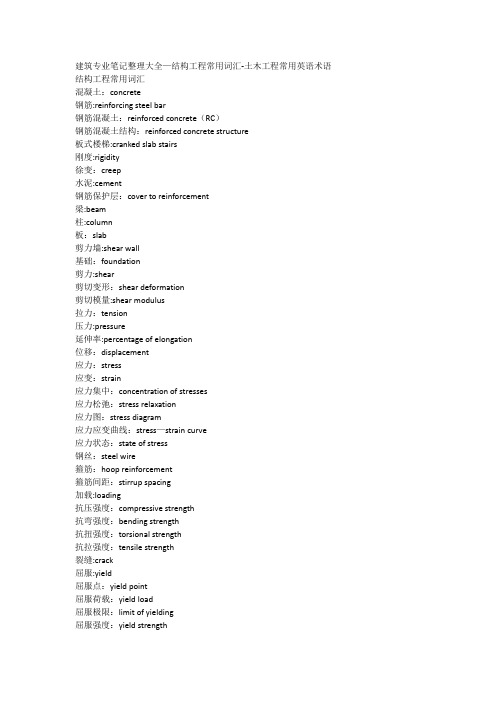
建筑专业笔记整理大全—结构工程常用词汇-土木工程常用英语术语结构工程常用词汇混凝土:concrete钢筋:reinforcing steel bar钢筋混凝土:reinforced concrete(RC)钢筋混凝土结构:reinforced concrete structure板式楼梯:cranked slab stairs刚度:rigidity徐变:creep水泥:cement钢筋保护层:cover to reinforcement梁:beam柱:column板:slab剪力墙:shear wall基础:foundation剪力:shear剪切变形:shear deformation剪切模量:shear modulus拉力:tension压力:pressure延伸率:percentage of elongation位移:displacement应力:stress应变:strain应力集中:concentration of stresses应力松弛:stress relaxation应力图:stress diagram应力应变曲线:stress—strain curve应力状态:state of stress钢丝:steel wire箍筋:hoop reinforcement箍筋间距:stirrup spacing加载:loading抗压强度:compressive strength抗弯强度:bending strength抗扭强度:torsional strength抗拉强度:tensile strength裂缝:crack屈服:yield屈服点:yield point屈服荷载:yield load屈服极限:limit of yielding屈服强度:yield strength屈服强度下限:lower limit of yield荷载:load横截面:cross section承载力:bearing capacity承重结构:bearing structure弹性模量:elastic modulus预应力钢筋混凝土:prestressed reinforced concrete预应力钢筋:prestressed reinforcement预应力损失:loss of prestress预制板:precast slab现浇钢筋混凝土结构:cast—in—place reinforced concrete 双向配筋:two-way reinforcement主梁:main beam次梁:secondary beam弯矩:moment悬臂梁:cantilever beam延性:ductileity受弯构件:member in bending受拉区:tensile region受压区:compressive region塑性:plasticity轴向压力:axial pressure轴向拉力:axial tension吊车梁:crane beam可靠性:reliability粘结力:cohesive force外力:external force弯起钢筋:bent—up bar弯曲破坏:bending failure屋架:roof truss素混凝土:non—reinforced concrete无梁楼盖:flat slab配筋率:reinforcement ratio配箍率:stirrup ratio泊松比:Poisson’s ratio偏心受拉:eccentric tension偏心受压:eccentric compression偏心距:eccentric distance疲劳强度:fatigue strength偏心荷载:eccentric load跨度:span跨高比:span-to-depth ratio跨中荷载:midspan load框架结构:frame structure集中荷载:concentrated load分布荷载:distribution load分布钢筋:distribution steel挠度:deflection设计荷载:design load设计强度:design strength构造:construction简支梁:simple beam截面面积:area of section浇注:pouring浇注混凝土:concreting钢筋搭接:bar splicing刚架:rigid frame脆性:brittleness脆性破坏:brittle failure土木工程常用英语术语第一节一般术语1。
常用水泥专业英语词汇表

常用水泥专业英语词汇表Aabbreviate v.缩写,简略abrasive n.磨料a.磨料的;研磨的accelerate 加快…的速度,变快,使加速additional raw material 辅助原料aeration n.冲气;通风;分散aeration pad 冲气板aggregate 聚集,骨料,凝结agitation n.搅拌,搅动air seal 密封装置air-swept ball mill 风扫式球磨机Alite n.阿利特,A矿alkali n.碱,碱性alumina n.氧化铝;矾土aluminate 铝酸盐alumina ratio 铝率,铝氧率aluminium n.铝alumino-ferrite 铁铝酸盐ancillary a. 辅助的n.辅助设备anhydrite n. 硬石膏,无水石膏AR(alumina ratio) 铝率,铝氧率alagonite n.文石,霰石argillaceous a.粘土质的arrangement n.排列,布置,装置布置;协议as dug 天然的ash 灰,灰分ash incorporation 煤灰掺入ash ring 煤灰圈autogenous grinding 无介质粉磨auxiliary a.附属的,辅助的autoclave 蒸压釜,热压器auxiliary burner 辅助燃烧器axial a.轴的,轴向的Bbalance n.平衡,平衡表,差额,天平ball mill 球磨机barite(s) n.重晶石barium 钡basic brick 碱性(耐火)砖basis n.基准[础、数],基本原理,主要成分batch n.批量,批料;a.分批的,间歇的bauxite n.铝土矿,(铁)矾土Belite 贝里特,B矿belt coveyor 带式输送机beneficiate 富有,富集,富集操作beneficiation n.富有,选矿binder 粘结剂,粘合剂blast furnace slag 高炉矿渣blasting 爆破(炸),鼓风bleed v.&n.泌析,排放,放风blending 混合,掺合blending stockpile (预)均化堆场brittleness n.脆性(度)bucket elevator 斗式提升机buffer 缓冲bulk 体积,主体,整体,笨重,块状,凝结bulk density 松(堆)密度,容积密度bulk tanker 散装车(罐)burn v. n.燃烧,煅烧,烧成burnability n.易烧性burning zone 烧成带,燃烧带byproduct n.副产品Ccalcareous a.钙质的,石灰质的calcine v.& n. 煅烧calcining zone 煅烧带,(碳酸盐)分解带calcite n.方解石calcium 钙calcium carbonate 碳酸钙calcium fluoride 氟化钙calcium silicate 硅酸钙calcium sulfate 硫酸钙,石膏calcium oxide 氧化钙calibration n.校准,标定,分度,刻度calories 卡(热量单位)calorific 热量的,含热量的carbon dioxide 二氧化碳cascade n. a. v.串级,串联(的),梯流,成瀑布落下caution 小心cement n.水泥v.加水泥于,胶结cementatious 有粘结性的,胶结的chain zone 链条带chalk n.白垩chamber n. (仓)室charcteristio a.特有的,表示特性的n.特征(点、性),性能,特性曲线chemical composition 化学组成china clay 高岭土chloride n.氯化物chlorine n.氯,氯气chrome n.铬chrome magnesite brick 镁铬砖chromium n.铬circuit n.流程,系统,工序,循环,回路classification n.分级classifier 分级机,选粉机classifying liner 分级衬板classifying lining 分级衬板clay n.粘土clinker n.熟料,炉渣,熔渣v. 烧成(结)clinker burning 熟料煅烧,熟料烧成clinker coating 窑皮clinker coating 熟料圈clinkering zone 烧成带closed-circuit 闭路(系统、流程),圈流(系统)closed loop control 闭环控制coal n.煤coal ash 煤灰coating of fluxed linker 窑皮co-current flow 同流coherent 粘结性的,粘聚性的coke n.焦碳colliery n.煤矿combinability n.可(易)化合性combustible a.可(易)燃性n.燃烧,(pl)易燃品,可燃物comparable 可以比较的compartment n.仓、室、间格compatible 协调的,一致的,相符合的,相配套的comply 遵守,遵循component n.组分,成分,组成物,组成部件,元(构、零)件composition 构造,组成,作品compressive strength 抗压强度compulsory 强迫的,强制的,必要的concrete n.混凝土v.配制混凝土、浇灌混凝土 a.混凝土的condensation n.冷凝configuration n.外形,结构,排列,配制conserve v.保存,节省consisteney n.稠度,稳定,一致性,连续性constituent 组成物,构成要素constitute 组成,构成construction 建造,建筑consumption n.消耗(量)contaminate v.污染control v. n.控制convey v.运输cooler n.冷却机cooler zone 冷却带copper n.铜coral reef 珊瑚礁corrective ingredient 校正部分corrosion 腐蚀,侵蚀,受损counter-current flow 逆流cretaceous a.白垩纪(系)的,白垩的criterion (pl. criteria) n.判据,标准,规范、准则、准数、指标crush v.破碎crystal a.晶体的,结晶的n.结晶,晶体culminating a.终极的,最后的,达到绝顶的current cost 市价cushion n.缓冲垫v.缓冲cyclone 旋风(流),旋风筒,旋风收尘器Ddecade 十年decarbonation n.(碳酸盐)分解decarbonation zone (碳酸盐)分解带decomposition n.分解deflocculating agent 反絮凝剂densification n.密(实)化,稠化,密(封)dentical 相等的,等同的deposite v. n. 沉积,矿床,矿层detrimental 有害的device n.设备devise n.设计,发明,创造,发生diaphragm n.隔板(膜),隔仓板diatomaceous earth 硅藻土dicalcium silicate 硅酸二钙dilate 稀释的,冲淡的discharge v. n.卸料discrete a.不连续的,离散的,分立的disintegrator n.粉碎机dispatch v. n.装运,发送(运)dissolve v.溶解distinguish 区分,辨别distribution n.分布,分发dolomite n.白云石dolomite brick 白云石耐火砖dry process 干法dry process kiln 干法窑drying 干燥,烘干drying zone 干燥带duct n.管道,通道durability n.耐久(性)dust collector 收尘器dwindle v.减少(小),衰落,退化dynamic equilibrium 动态平衡Eeffect n.效应(力),影响,(有效)作用,效果,实行(施)v.引起,实现effective a.有效的,生效的,实际的effectiveness n.效率(能、应、果、力),有效性,能行性efficiency n.效率(能、应、果、力),有效系数,实效经济性electrostatic precipitator ( 静)电收尘器elevator n.提升机emission n.散发,放出,发(辐)射,散发物energy consumption 能源消耗entail 引起,导致,造成equalibium n.平衡equipment n.设备,工具error n.误差estuarine a.河口的,港湾的evaporation n.蒸发evolution 开展,发展,进化excessive 多的,过多的,过分的,极端的exhaust gas 排出的气体,废气exhibit v.n. 陈列(品),呈现,显示,展览(品、会)exothermic a.放热的expansion n.膨胀,扩大exploitation n.开发(拓采),利(使)用,运转(行),维护explosion n.爆破(炸),激增extender n.补气料,混合材料,扩充器extraction n.引(排)出,萃取,精选,摘要extruder n.挤压(成型)机Ffalse set 假凝false setting 假凝fan n.通风机,风扇feed v. n.供料,加料,喂料,喂入的料feeder n.喂料机feedstock n.原料feldspar n.长石ferrite n.铁酸盐ferrite phase 铁(酸盐)相ferrite phase solid solution 铁(酸盐)相固溶体filter n.过滤机filter cake滤饼fineness 细度finished product 成品flash furnace 快速分解炉,闪燃分解炉flint n.燧石,火石a.燧石(制)的flotation= floatation n.浮选(法)flow v.n.流动,流量flow chart 流程图flue dust 窑灰,飞灰fluidis(z)ation n.流态化fluidis(z)e v.使流态化fluidis(z)ed bed 流化床,沸腾床fluid-bed furnace 流化床(反应)炉,沸腾炉fluorine n.氟fluoride n.氟化物fluosilicate n氟硅酸盐fluospar n.萤石,氟化钙flux 流,流动,通量,流量,涡量,焊剂,(助)熔剂fluxing 助熔的fluxing agent 助熔剂free lime 游离石灰,游离氧化钙froth 起沫,发泡,沸腾,翻浆fuel n.燃料fuse 熔化,熔融fusion n.熔化(解、融),聚变Ggeneric name 属名geologic(al) a.地质(学上)的geological survey a.地质调查(勘测)glauconite n.海绿石gradient n.斜(坡)度,变化率gram 克grate 炉格,摩擦gravity air separator 重力空气分离器(粗粉分离器)grind v.粉磨grindability n.易磨性grinding media 研磨介质,研磨体grit n.硬渣,粗砂grit return 粗粒返回grinding stage 研磨阶段ground 研磨,粉磨,粉碎gypsum n.石膏gyratory crusher 旋回(圆锥)破碎机Hhammer n.锤hammer crusher 锤式破碎机hammer mill 锤碎机hard and fast 严格的,一成不变的,不许变动的hardening 硬化(作用)hardness n.硬度hazard n.危险heat treatment 热处理,热加工heat transfer 热传递,传热hemihydrate n.半水化合物high alumina brick 高铝砖high-limed 高(氧化)钙的homogeneous a.均匀的hood n.罩,通风罩hopper n.漏斗,给料斗hot exit gas 热废气household refuse 家庭垃圾(废渣)humidity n.湿度hydration n.水化(作用),水合,加水反应hydration product 水化产物,水化生成物hydraulic 液压的,水力的,水硬性的hydraulic cement 水硬性水泥,水硬性胶凝材料hydraulic reactivity 水硬活性hydrocyclone 水力旋流器hygroscopic a.吸湿的,吸水的Iignition 点燃,点火,着火,发火illite n.伊利石illitic a.伊利石的impact 冲击,影响impracticable 不能实现的,不能使用的impurity n.杂质incorporation n.结合,掺入,公司,团体indenter n.(硬度试验)压头indicating and recording instrument指示和记录仪表ingredient n.配料,(混合料的)成分,组成部分initially 开始的,起初injection n.引入,注入,进入inleak v.漏入inleakage a.漏入insoluble 不可溶解的installation n.装置,设备,安装instrument n.仪器,工具,装置,手段v.用仪器装备instrumental a.仪器的instrumentation 测量设备,检测仪表instrument analysis 仪器分析insufflate v.吹入interdispersion n.相互分(扩)散interference n.干扰,干涉intergrind 共同粉磨,互磨,混磨intermittent a.间歇的intermix v.混合,掺合,搅拌ion 离子iron ore 铁矿,铁矿石iron oxide 氧化铁iron pyrites 黄铁矿isomorphous substitution (类质)同晶取代Kkaolinite n.高岭石kaolinitic a.高岭石的kiln n.窑v.窑烧kiln department 窑房,烧成车间kiln feed 入窑生料kiln food 窑罩kiln process 煅烧过程Llaterite 红土,红泥lat strength 后期强度layout n.布置legislation n.立法,法规(律)lepol 立波尔(窑)level n.含量,水平,等级a.水平的,等位的v.整平,找平LHC(Low-Heat Cement) 低热水泥lime n.石灰,氧化钙lime kiln 石灰窑lime saturation factor 石灰饱和因数lime silicate 硅酸钙limestone n.石灰石(岩)liquid phase 液相liter weight 立升重load cell 测力传感器long dry process kiln 干法长窑longitudinal section 纵(向)断面long wet process kiln 湿法长窑loss in(of) weight 失重louver vanes 百叶导向器low-frequancy a.低频率的LSF(lime saturation factor) 石灰饱和因数Mmag-chrome brick 镁铬砖magnesia n.氧化镁,镁土,菱镁矿magnesite 碳酸镁,菱镁矿magnesite brick 镁砖magnesium n.镁magnesium carbonate 碳酸镁magnesium oxide 氧化镁maintenance n.保养,维修(护)manganese n.锰manufacture n.v.制造marl n.泥灰岩,灰岩MC(Masonry Cement) 石造水泥mesh 目,筛,网眼mica n.云母microstructure n.显微结构(组织、构造)mimic a.模拟的n.仿造物v.模拟minestoneminerlis(z)e v.矿化,成矿mineralis(z)er v.矿化剂mineralogical composition 矿物组成minor component 微量(次要)组分mixture 混合,混合物mobile crnsher 移动式破碎机modification n.变体,改性,修正,限制modulus (pl. moduli) n.率值moist basis 湿基moisture content 湿含量,含水量monitor n.监视(测)器,控制测量仪表v. 监视(测),控制monolithic 块体的,整体浇注的montmorillonoid n.蒙脱石mortar n.水泥砂浆,砂浆,灰浆,研钵multifarious 各种各样的,多方面的multistage n.多级(段)Nnational standard 国家标准natural gas 天然气nodule n.料球,结节,小结nominal a.额定的,标称的nonhygroscopic a.不吸水(潮)的non-stuctual a.不用于结构上的,不作结构材料的norm n.规范,典型,标准nozzle n.喷嘴ntermediate 中间的numerator n.(分数的)分子Oobsolescence n.逐渐过时,陈旧,报废obtainable 可以获得的,可以得到的octant n.八分圆(体、区),圆周的八分之一offset n.v.弥补,抵消oil-shale n.油页岩on-stream 在运转中,操作中OPC(Ordinary Portland Cement)普通波特兰水泥open circuit 开路,开流opening 筛孔,孔洞,开口ore n.矿organic a.有机(体)的orific n.(小)孔output n.产量,流量,输出,输出功率,效率overburning 过烧overflow v.n.溢流(出)oversized residue 筛余oxide composition 氧化物组成,(化学组成)oyster 牡蛎Ppacking 包装,装填,堆砌parameter n.参数partial 部分的particle size 粒径,粒度PBFSC(Portland Blast Furnace Slag Cement)波特兰高炉矿渣水泥performance n.性能,特性,施行,执行performance tests 性能测试permeability 渗透性,透气性,渗蚀度periclase n.方镁石phase 状态,阶段,相,相位phosphate n.磷酸盐phosphorus n.磷phosphorus oxide 五氧化二磷place v.浇灌(混凝土),放(配、设)置,安排planetary cooler 多筒冷却机plasma n.等离子plaster n.熟石膏,灰浆pkasticity n.可塑性pneumatic a.空气(气体)的,充气的,气(风)动的pneumatic conveyer 空气(风动、气力)输送装置polymorph 多型,多晶型porosity n.空(孔)隙的,多孔性port n.机口,门potassium oxide 氧化钾potential a.潜在的,可能的,势(差),位(差)的n. 潜力,势(能),位(能)Portland cement 波特兰水泥,硅酸盐水泥pozzolan n.火山灰pozzolanic activity 火山灰活性PPC(Portland Pozzolana Cement) 火山灰水泥practice n.实践,做法pre-calciner 预分解炉,窑外分解炉precipitate 促成,造成,沉淀precipitator n.沉淀器,收(除)尘器preheater n.预热器preheating 预热preheating zone 预热带preparation a.制备pressure 压力pressure drop 压降primary (combustion) air 一次空气,一次风proceedings 记录,会报,会刊,学报proportion v.使成比例,(按比例定量)配合n.比例,部分(pl.)大小prospect n.展望,预期pulp 柔软的材料,木浆,纸浆pulveris(z)e v.粉磨,粉化,雾化pulveris(z)ed coal 煤粉pump n.泵v.泵送pumping 泵送pyrite n.黄铁矿pyroprocessing n.高温处理过程,热过程Qquadrant n.四分之一圆(圆周),象限quantitative 与量有关的,定量的quarry n.采石场,石矿,方(菱)形砖v.(露天)开采,采掘quartz n.石英quartzite n.石英岩(砂),硅岩quaternary system 四元(体)系,四元系统quench 熄灭,结束,淬火,冷浸Rradiation n.辐射rake n.倾斜(度),倾角,(矿)斜脉raw feed 喂入的生料raw material 原料raw meal 生料reagglomeration n.(再)结块,成团reactivity 活性,活动性,反应能力recirculate v.再循环,回流recirculation n.再循环,回流reclaim v.回收,再生,(从贮存料)取出(物料)recover v.回收,再置reducing condition 还原状态(条件)refactory 耐火的,耐熔的,耐火材料refactory brick 耐火砖regime n.制度,状态regulate v.调节reject v.剔除,否决n.等外品,不合格品,废矿,尾矿removal n.除去,逸出,卸出,移动(开)reserve n.储量v.储备residence time 停留时间residue 剩余(物),残余retardation 减速,延缓retention n.保留,停留,保持RHC(Rapid-Hardening Cement) 快硬水泥rip v.挖,剥,撕,割rod mill 棒磨roller mill 辊式磨,立式磨rotary kiln 回转窑,旋窑Ssample n.样品,试样v.取(抽)样,试验…的样品性能sampling point .取(抽)样点sand shale 砂页岩satellite n.卫星scheme n.设计,配置,系统,图表,(示意、流程、平面)图scrape v.n. 挖,剥,削,刮screen n.筛screw n.螺旋secondary (combustion ) air 二次空气,二次风section n.截面,剖面图,部分,段self-propelled a.自行(走)的,自动推进的semi-automated a.半自动化的semi-dry process kiln 半干法窑semi-wet process kiln 半湿法窑sensor 传感器separator n.分离器,选粉机sequence n.顺序,程序set regulator 调凝剂set v.放置,定位,凝结(固)n.(一)套(组、部、副…),装置,机组,方位,凝结(固)a. 凝结(固)的,装好的set retarder 缓凝剂setting time 凝结时间settlement n.解决,固定沉淀(物),沉降sewage n.污水(物)shale n.页岩short kilns with grate heat exchangers带篦式换热器的短窑short dry process kiln with suspension preheaters 带悬浮预热器的干法短窑sieve 筛sieve bend 弧形筛silica n.二氧化硅,硅石silica ratio 硅率,硅酸率silicate n.硅酸盐siliceous a含硅的,硅质的siliceous limestone 硅质(石)灰岩silico-fluoride 氟硅酸盐,氟硅化物silo n.圆筒仓,库silicon n.硅size reduction 粉碎silice v.n.切(成薄片),铲sinter 烧结,烧成slag 矿渣,炉渣sludge n.淤渣,油泥sluggish 粘滞的,流动性低的slurry n.料浆,稀浆sodium oxide 氧化钠sophiscated a.复杂的,高级的,需要专门操作技术的sound a.正常的,完好的,安定的sound cement 安定(性合格)的水泥soundness 稳定性,固定性SP(suspension preheater ) 悬浮预热器span n.跨度specification 说明,技术规范specific gravity (weight) 比重spot sample 局部试样spout v.喷n.喷口(嘴),喷出,喷流SR(silica ratio) 硅率,硅酸率SRC(Sulphate Resisting Cement)抗硫酸盐水泥stark v.n.堆,叠standard n.标准standard deviation 标准偏差stationary 固定的,静止的steam raising 蒸发,产生蒸汽stem (from, out of) v.发生于,起源于sticky a.粘性的stipulate v.规定,约定stockpile n.v.储存(备),堆放,积累,料堆,资源蕴藏量stoppage 停止,停机storage n.储存(藏),仓库store n.v.贮藏,储备strength n.强度strength development 强度增进(过程)subsample n.子样品v.再(二次)取(抽)样substantially 实际上,根本性的,显著的,基本上substitute v.代替,取代n.代用品a.代用的sufficient 足够的,充分的supplementary fuel 辅助燃料susceptibility n.敏感度(性),灵敏性suspension 悬浮,悬吊;悬挂装置;悬浮(液)体suspension preheater 悬浮预热器swelling clay 膨润土swirl calciner 涡流分解炉system n.系统,装置Ttandem a.ad.串联的n.串联target n.目标,靶,指标tensile 拉力的,抗张的tensile strength 抗拉强度tetracalcium aluminoferrite 铁铝酸四钙thermal 热的,热学的,热量的thermal decomposition 热分解throughout n.生产量,通过量tonnage n.吨数(位)track n.痕迹,轨道,导板,导向装置tricalcium aluminate 铝酸三钙tricalcium silicate 硅酸三钙tubular mill 管磨tyre n.(窑或磨的)滚圈,轮胎Uultimately 最后,最终,基本,最大限度的underburning 欠烧undesirable 不合要求的,不理想的undesirably 不合要求地,不理想地uniformity n.均匀性,一致性unit n.单位,单元,设备,机组unsound a.不安定的unsoundness n.不安定uptake n.垂直(向上的)管道(孔道),上升烟道,上气道Vvariability n.易(可)变性,变化性,变率variation n.偏差,差异,变异,变种vein n.脉矿,纹理ventilate v.通风,排气,装以通风设备vertical(shaft)kiln 立窑vertical spindle mill 立式磨(辊式磨)vessel n.容器,炉身Vickers micro-indenter 显微维氏硬度计Wwater requirement 需水性,需水量wear v.n.磨损,耐磨wet process 湿法wet process kiln 湿法窑white cement 白水泥workability n.工作度,可加工性,和易性Xx-ray fluorescence analysis X射线荧光分析x-ray analysis X射线分析ZZinc n.锌。
土木工程概论专业词汇
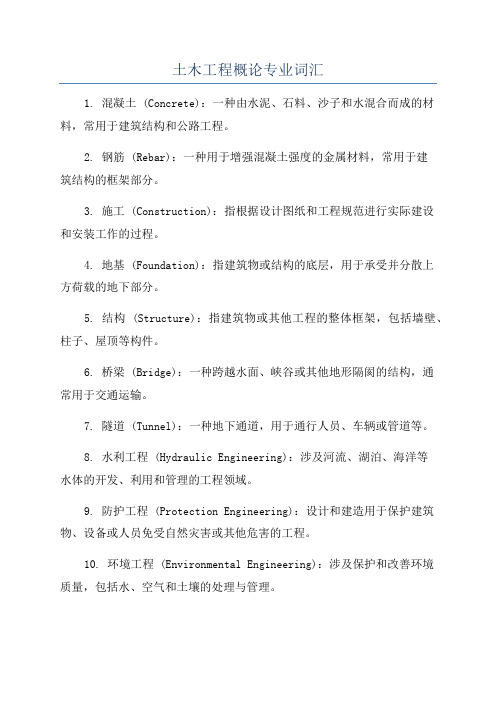
土木工程概论专业词汇1. 混凝土 (Concrete):一种由水泥、石料、沙子和水混合而成的材料,常用于建筑结构和公路工程。
2. 钢筋 (Rebar):一种用于增强混凝土强度的金属材料,常用于建筑结构的框架部分。
3. 施工 (Construction):指根据设计图纸和工程规范进行实际建设和安装工作的过程。
4. 地基 (Foundation):指建筑物或结构的底层,用于承受并分散上方荷载的地下部分。
5. 结构 (Structure):指建筑物或其他工程的整体框架,包括墙壁、柱子、屋顶等构件。
6. 桥梁 (Bridge):一种跨越水面、峡谷或其他地形隔阂的结构,通常用于交通运输。
7. 隧道 (Tunnel):一种地下通道,用于通行人员、车辆或管道等。
8. 水利工程 (Hydraulic Engineering):涉及河流、湖泊、海洋等水体的开发、利用和管理的工程领域。
9. 防护工程 (Protection Engineering):设计和建造用于保护建筑物、设备或人员免受自然灾害或其他危害的工程。
10. 环境工程 (Environmental Engineering):涉及保护和改善环境质量,包括水、空气和土壤的处理与管理。
11. 岩土工程 (Geotechnical Engineering):研究土壤和岩石的特性,以应对土体工程问题和地质灾害。
12. 施工管理 (Construction Management):通过规划、组织、指导和监督工程项目的实施过程,以实现项目目标。
13. 工程测量 (Engineering Survey):使用测量仪器和技术测量地理空间数据,为工程设计和施工提供准确的空间信息。
14. 施工安全 (Construction Safety):指在施工过程中采取安全措施,预防和减少事故和伤害的风险。
15. 工程标准 (Engineering Standards):指规定工程设计、施工和验收的技术规范,以确保工程质量和安全性。
混凝土专业英语

➢ Members with flexure (受弯构件) 各种单独的梁、板以及由梁组成整体的楼盖、屋盖等。
➢ Members with compression (受压构件) 柱、剪力墙和屋架的压杆等。
➢ Members with tension(受拉构件) 如屋架的拉杆、水池的池壁等。
➢ Members with torsion(受扭构件) 如带有悬挑雨蓬的过梁、框架的边梁等。
➢ It is generally known that concrete has high compressive strength and low resistance to tension. Its tensile strength is approximately one-tenth of its compressive strength.
专业英语讲稿
CHAPTER 1 INTRODUCTION(绪论)
1.1 BASIC CONCEPTS AND CHARACTERISTICS OF REINFORCED CONCRETE
➢ Plain concrete is formed from hardened mixture of cement, water, fine aggregate, coarse aggregate (crushed stone or gravel), air, and often other admixtures.
混凝土行业中英文单词对照表
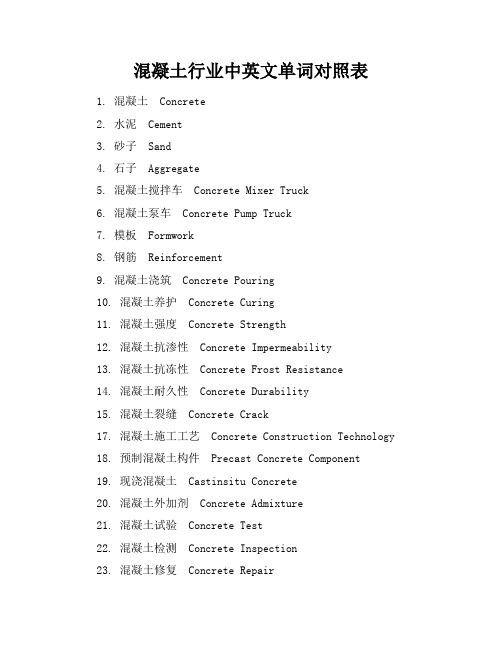
混凝土行业中英文单词对照表1. 混凝土 Concrete2. 水泥 Cement3. 砂子 Sand4. 石子 Aggregate5. 混凝土搅拌车 Concrete Mixer Truck6. 混凝土泵车 Concrete Pump Truck7. 模板 Formwork8. 钢筋 Reinforcement9. 混凝土浇筑 Concrete Pouring10. 混凝土养护 Concrete Curing11. 混凝土强度 Concrete Strength12. 混凝土抗渗性 Concrete Impermeability13. 混凝土抗冻性 Concrete Frost Resistance14. 混凝土耐久性 Concrete Durability15. 混凝土裂缝 Concrete Crack17. 混凝土施工工艺 Concrete Construction Technology18. 预制混凝土构件 Precast Concrete Component19. 现浇混凝土 Castinsitu Concrete20. 混凝土外加剂 Concrete Admixture21. 混凝土试验 Concrete Test22. 混凝土检测 Concrete Inspection23. 混凝土修复 Concrete Repair24. 混凝土结构设计 Concrete Structure Design25. 混凝土建筑 Concrete Construction26. 混凝土框架 Concrete Frame27. 混凝土梁 Concrete Beam28. 混凝土柱 Concrete Column29. 混凝土板 Concrete Slab30. 混凝土基础 Concrete Foundation31. 混凝土路面 Concrete Pavement32. 混凝土桥梁 Concrete Bridge33. 混凝土隧道 Concrete Tunnel34. 混凝土预制件 Concrete Precast35. 混凝土配合比 Concrete Mix Design36. 混凝土坍落度 Concrete Slump37. 混凝土搅拌站 Concrete Batching Plant38. 混凝土输送带 Concrete Conveyor Belt39. 混凝土喷射 Concrete Spraying40. 混凝土装饰 Concrete Decoration41. 混凝土着色 Concrete Staining42. 混凝土雕刻 Concrete Sculpting43. 混凝土保护剂 Concrete Sealant44. 混凝土修补材料 Concrete Repair Mortar45. 混凝土表面处理 Concrete Surface Treatment46. 混凝土防滑 Concrete Antislip47. 混凝土隔声 Concrete Soundproofing48. 混凝土防火 Concrete Fireproofing49. 混凝土轻质 Lightweight Concrete50. 混凝土透水 Permeable Concrete这份对照表旨在帮助行业内的人员更好地理解和沟通混凝土相关的术语。
土木工程专业英语词汇短语总结

土木工程专业英语词汇短语总结.doc 标题:土木工程专业英语词汇短语总结一、前言介绍土木工程专业英语的重要性。
阐述词汇短语总结的目的和应用场景。
二、基础词汇列出土木工程领域中的基础词汇。
为每个词汇提供定义和例句。
三、结构工程钢筋(Reinforcement)混凝土(Concrete)梁(Beam)柱(Column)地基(Foundation)四、岩土工程土壤(Soil)岩石(Rock)边坡(Slope)支护(Support)地基处理(Foundation Treatment)五、水文与水资源工程水坝(Dam)水塔(Water Tower)运河(Canal)洪水(Flood)水资源管理(Water Resources Management)六、交通工程道路(Road)桥梁(Bridge)隧道(Tunnel)交通规划(Traffic Planning)交通信号(Traffic Signal)七、环境工程污染(Pollution)废物处理(Waste Treatment)环境影响评估(Environmental Impact Assessment)可持续性(Sustainability)绿色建筑(Green Building)八、施工管理施工计划(Construction Schedule)工程预算(Engineering Budget)质量控制(Quality Control)安全管理(Safety Management)项目监理(Project Supervision)九、材料科学材料强度(Material Strength)耐久性(Durability)抗渗性(Waterproofing)抗压强度(Compressive Strength)弹性模量(Elastic Modulus)十、测量与绘图测量(Surveying)平面图(Plan)剖面图(Section)立面图(Elevation)施工图纸(Construction Drawings)十一、专业短语与表达工程竣工(Project Completion)工程变更(Engineering Change)工程验收(Project Acceptance)工程质量(Engineering Quality)工程进度(Project Progress)十二、结语总结土木工程专业英语词汇的重要性。
混凝土专业英语
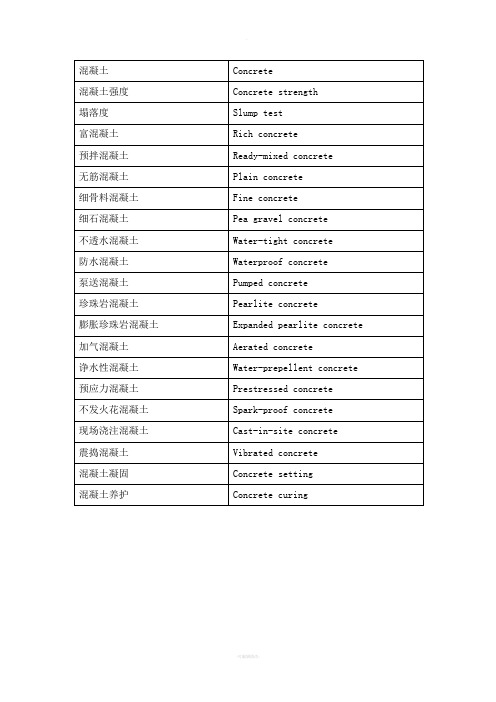
Concrete curing
欢迎您的下载,
资料仅供参考!
致力为企业和个人提供合同协议,策划案计划书,学习课件等等
打造全网一站式需求
混凝土
Concrete
混凝土强度
Concrete strength
塌落度
Slump test
富混凝土
Rich concrete
预拌混凝土
Ready-mixed concrete
无筋混凝土
Plain concrete
细骨料混凝土
Fine concrete
细石混凝土
Pea gravel concrete
建筑材料的一些专业英语5
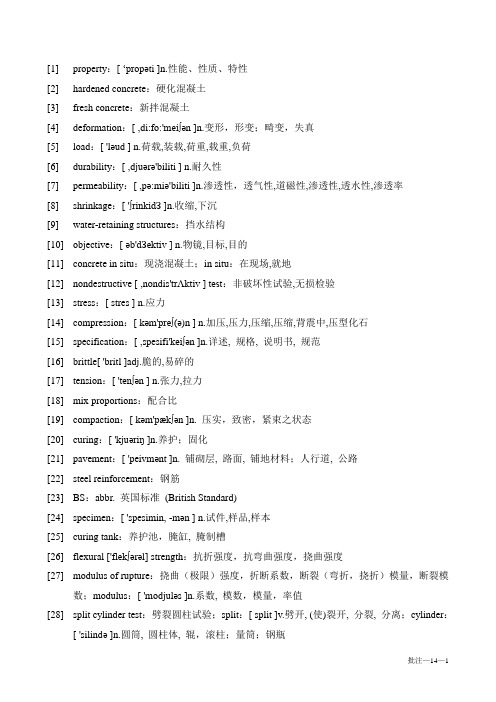
[1]property:[ ‘pr opəti ]n.性能、性质、特性[2]hardened concrete:硬化混凝土[3]fresh concrete:新拌混凝土[4]deformation:[ ,di:fo:'mei∫ən ]n.变形,形变;畸变,失真[5]load:[ 'ləud ] n.荷载,装载,荷重,载重,负荷[6]durability:[ ,djuərə'biliti ] n.耐久性[7]permeability:[ ,pə:miə'biliti ]n.渗透性,透气性,道磁性,渗透性,透水性,渗透率[8]shrinkage:[ '∫rinkidЗ ]n.收缩,下沉[9]water-retaining structures:挡水结构[10]objective:[ əb'dЗektiv ] n.物镜,目标,目的[11]concrete in situ:现浇混凝土;in situ:在现场,就地[12]nondestructive [ ,nondis'trΛktiv ] test:非破坏性试验,无损检验[13]stress:[ stres ] n.应力[14]compression:[ kəm'pre∫(ə)n ] n.加压,压力,压缩,压缩,背震中,压型化石[15]specification:[ ,spesifi'kei∫ən ]n.详述, 规格, 说明书, 规范[16]brittle[ 'britl ]adj.脆的,易碎的[17]tension:[ 'ten∫ən ] n.张力,拉力[18]mix proportions:配合比[19]compaction:[ kəm'pæk∫ən ]n. 压实,致密,紧束之状态[20]curing:[ 'kjuəriŋ ]n.养护;固化[21]pavement:[ 'peivmənt ]n. 铺砌层, 路面, 铺地材料;人行道, 公路[22]steel reinforcement:钢筋[23]BS:abbr. 英国标准(British Standard)[24]specimen:[ 'spesimin, -mən ] n.试件,样品,样本[25]curing tank:养护池,腌缸, 腌制槽[26]flexural ['flek∫ərəl] strength:抗折强度,抗弯曲强度,挠曲强度[27]modulus of rupture:挠曲(极限)强度,折断系数,断裂(弯折,挠折)模量,断裂模数;modulus:[ 'modjuləs ]n.系数, 模数,模量,率值[28]split cylinder test:劈裂圆柱试验;split:[ split ]v.劈开, (使)裂开, 分裂, 分离;cylinder:[ 'silində ]n.圆筒, 圆柱体, 辊,滚柱;量筒;钢瓶[29]plane:[ plein ]n.平面, 飞机, 水平, 程度, 刨[30]diameter:[ dai'æmitə ]n.直径[31]simply supported plain concrete beam:简支素混凝土梁;plain concrete:素混凝土,无筋混凝土[32]its third points:它的每个三分之一处[33]as a guide:原则上[34]constituent:[ kən'stitjuənt]n.成分,组分,构成[35]fineness:[ 'fainnis ]n. 细度, 纯度;fine:[ fain ]adj. 细的, 美好的, 杰出的, 稀薄的[36]chemical composition:化学成分[组成][37]tricalcium silicate:n.硅酸三钙(C3S);tricalcium:[ trai'kælsiəm ]n.三钙;silicate:[ 'silikit ]n.[化]硅酸盐[38]dicalcium silicate:n.硅酸二钙(C2S);dicalcium:[ dai'kælsiəm ]n.二钙[39]eventually:[i'ventjuəli]adv.最后, 终于[40]gel:[ dЗel ]n.凝胶体,凝胶[41]water-cement ratio:水灰比(w/c);ratio:[ 'rei∫iəu ]n.比, 比率;the ratio of sth. to sth.:…与…之比[42]void:[ void ]n. 空隙,孔隙;adj. 空白的,空的[43]facilitate:[ fə’siliteit ]vt.(不以人作主语的)使容易, 使便利, 推动, 帮助, 促进[44]placing:n.浇筑,安装[45]in excess of:超过(多于),较...为多[46]porous:[ 'po:rəs ]adj.多孔的,多孔状,疏松的[47]with a view to:着眼于, 以...为目的, 考虑到[48]illustrate:[ 'iləstreit ]vt.举例说明, 图解, 说明[49]matrix:[ 'meitriks ] n.胶结材料,填充料,基质[50]interface:[ 'intə(:),feis ] n.界面,分界面,接触面[51]bond:[ bond ] n.结合,连接,粘结[52]surface texture:表面状态, 表面特性, 表面质量, 表面结构;texture:[ 'tekst∫ə ]n.结构,组织,饰纹,纹理,网纹[53]cleanliness:[ 'klenlinis ] n.清洁度,净度[54]rounded:[ 'raundid ]adj.全面的, 圆形的[55]angular:[ 'æŋgjulə ] adj.角的,有棱角的,带角的,棱角状的[56]irregular:[ i'regjulə ]adj.不规则的, 无规律的[57]rough:[ rΛf ] adj.粗糙的,不平的,粗制的[58]workability:[ ,wə:kə'biliti ]n.和易性,工作性,可加工性,可成形性[与可塑性有关],可操作性[59]coating:[ 'kəutiŋ ]n.涂料;涂层,粘胶;(回转窑)窑皮[60]silt:[ silt ]n.粉砂,淤泥[61]clay:[ klei ] n.粘土,泥土[62]weathered:[ 'weðəd] adj.风化的[63]decomposed:[ ,di:kəm'pəuzd ] adj.已分解的,已风化的[64]sound:[ saund ] adj.健全的,强壮的; n.声音,音响[65]beneath:[ bi'ni:θ ] prep.劣于,在...之下,不配; adv.在下面[66]be opposed [ ə'pəuzd ] by:被……抵消[67]available:[ ə'veiləbl ]adj.可用到的, 有效的, 可利用的, 有空的[68]optimum:[ 'optiməm ]adj.最佳,最适宜的[69]richness:[ 'rit∫nis ]n. 丰富,富饶,富度,丰满度[70]grading:[ 'g reidiŋ ]n.颗粒级配,分等,分级[71]provided:[ prə:'vaidid ]conj.只要,倘若;预备好的[72]due:[ dju: ] adj.应得的, 应付的, 正当的, 预期的, (车、船预定)应到的[73]segregation:[ ,segri'g ei∫ən ]n.分层,离析[74]suitability:[ ,sju:tə'biliti ]n.合适, 适当, 相配, 适宜性,适应性,适用性[75]to some extent:在某种程度上,有点儿[76]alkaline:[ 'ælkəlain ]adj.[化]碱的, 碱性的[77]usage:[ 'ju:zidЗ ] n.使用,习惯,用法[78]accelerator [ æk'seləreitə ]:n.早强剂;促凝剂;促进剂[79]air-entraining [ in'treiniŋ ] agent:air entrainer [ in'treinə ],加气剂[80]concrete:[ 'konkri:t ]adj.具体的,有形的;n.混凝土;v.用混凝土修筑,浇混凝土,凝结[81]dosage:[ 'dəusidЗ ]n. 配料量;剂量,用量[82]effectiveness:[ i'fektivnis ] n.效率,有效性,能行性[83]constant:[ 'konstənt ]n.[数、物]常数, 恒量;adj.不变的, 持续的, 坚决的[84]air content:含气量[85]preparation:[ ,prepə'rei∫ən ] n.预加工,配制,准备工作[86]consistent:[ kən'sistənt ] adj.一致的(相容的,坚实的)[87]homogeneous:[ ,homəu'dЗi:njəs ] adj.均匀的,均质的,均一的[88]probability:[ ,probə'biliti ]n.可能性, 或然性, 概率[89]bleeding:[ 'bli:diŋ ]n.泌水性;析水;色料渗开;印流[涂料][90]honeycombing:[ 'hΛnikəumiŋ ]n.蜂窝结构,蜂窝麻面[91]operative:[ 'opərətiv, 'opəreitiv ] n.职工,技工[92]prerequisite:[ 'pri:'rekwizit ] n.先决条件[93]moisture:[ 'mo ist∫ə ]n. 湿度,水分,潮湿,湿气[94]evaporation:[ i,væpə'rei∫ən ]n.蒸发(作用)[95]relative humidity:相对湿度;humidity:[ hju:'miditi ]n. 湿度,湿气,潮湿[96]velocity:[ vi'lositi ] n.速度, 速率,周转率[97]initial:[ i'ni∫əl ] adj.初始的,最初的,开始的[98]moist curing:湿养护,雾室养护;water curing:水处理,水养护[99]apparent [ ə'pærənt ] strength:表观强度[100]resumption:[ ri'zΛmp∫ən ] n.收回,恢复,重新开始[101]the product of age and curing temperature:时度积;product:n.产品,产物,乘积[102]maturity:[ mə'tjuəriti ] n.成熟度,熟成度,老化[103]applicability:[ ,æplikə'biləti ] n.适用性,适应性[104]interpret:[ in'tə:prit ] v.解释, 说明, 口译, 通译[105]square prism:正四棱柱体;prism:[ 'prizəm ]n.[物]棱镜, [数]棱柱[106]height-diameter ratio:高度-直径比[107]platen:[ 'plætən ] n.压板,台板,压机压板[108]slenderness:[ 'slendənis ] n.细长度[109]moisture content:含水量[110]correction factor:修正系数,修正因数,校正系数;correction:[ kə'rek∫ən ]n.改正, 修正[111]air-dry:[ 'εədrai ] adj.完全风干状态的[112]saturated:[ 'sæt∫əreitid ]adj.饱和的,渗透的,深颜色的[113]wet concrete:塑性混凝土,水灰比高的混凝土[114]differential shrinkage:不均匀收缩,差示收缩量,差异收缩量;differential:[ ,difə'ren∫əl ]n.有差别的,差动的,微分的[115]lateral confining pressure:侧限压力;lateral:[ 'lætərəl ] adj.横(向)的, 侧面的;confining:[ kən'fainiŋ ] adj.限制的;拘束的;狭窄的;偏狭的[116]static loading:静载荷, 静负荷;static:[ 'stætik ]adj.静态的, 静力的[117]nominal strength:标称强度;nominal:[ 'nominl ] adj.额定的,标称的,名义上的[118]extent:[ iks'tent ]n.广度, 宽度, 长度, 范围, 程度, 区域[119]predominantly:[ pri'dominəntli ] adv.主要地;最显著地;占优势地[120]fatigue:[ fə'ti:g ] n.疲劳,疲乏[121]static strength:静力强度,静强度[122]frequency:[ 'fri:kwənsi ] n.频率,同率,次数[123]sustained load:持续载荷,持久加载,持续荷载;sustained:[ səs'teind ]adj.持续的,持久的[124]duration:[ djuə'rei∫ən ] n.持续,持续时间[125]consolidation:[ kən,soli'dei∫ən ] n.强化,固结[126]elastic deformation:弹性变形,弹性挠度;elastic:[ i'læstik]adj.弹性的[127]time-dependent deformation:时间相关的变形[128]creep:[ kri:p ] n.徐变,蠕变[129]nonlinear:[ 'non'liniə ] adj.非线性的,非直线的[130]quasi [ 'kwa:zi(:), 'kweisai ] -elastic:adj.准弹性的,似弹性的[131]modulus of elasticity:弹性模量,弹性系数,杨氏模量;elasticity:[ ilæs'tisiti ]n.弹性,弹力[132]Poisson’s ratio:泊松比,横向变形系数[133]strain:[ strein ] n.应变,变形,形变,过滤[134]deflection:[ di'flek∫ən ] n.挠度,变位,偏转[135]initial tangent modulus:初始切线模量,原切模数;tangent modulus:切线模量,切线模数,切向模量;tangent:[ 'tændЗənt ] n.切线, [数]正切[136]the secant modulus:割线模量,割线[正割]模数;secant:[ 'si:kənt ] n.割线, 正割[137]take into account:考虑(注意),顾及[138]stress-strain curve:应力—应变曲线[139]axial:[ 'æksiəl, -sjəl ] adj.轴的,轴向的[140]laterally:[ 'lætərəli ] adv.在侧面,横向地[141]multiphase:[ 'mΛl tifeiz ] n.多相; adj.多相的[142]stiffness:[ 'stifnis ] n.劲度,刚度,硬度[143]uniaxial:[ 'ju:ni'æksiəl ] adj.单轴的,同轴的[144]instantaneous:[ ,instən'teinjəs ] adj.瞬间的, 即刻的, 即时的[145]gradual:[ 'grædjuəl ] adj.逐渐的,逐步的,渐进的[146]creep recovery[ ri'kΛvəri ]:徐变(蠕变)回复[147]reversible:[ ri'və:səbl ] adj.可逆的[148]permanent:[ 'pə:mənənt ] adj.永久的,持久的[149]underestimate:[ '5Λndər'estimeit ] n.估计不足,低估[150]stability:[ stə'biliti ]n.稳定性,稳定度[151]prestressed [ 'pri:'stresd ] concrete:预应力混凝土[152]allowance:[ ə'lauəns ] n.允许,考虑,容限,间隙,修正量,补助,容许[153]prestressing tendons:预应力钢筋,预应力钢丝束;tendon:[ 'tendən ] n.[解]腱;钢丝束,锚索[154]with respect to:prep.关于,就...而论,相对于[155]be directly proportional to:正比于,与...成正比[156]equation:[ i'kwei∫ən ]n.相等, 平衡, 综合体, 因素, 方程式, 等式[157]assumption:[ ə'sΛmp∫ən ]n.假定, 设想, 假设[158]deterioration:[ di,tiəriə'rei∫ən ]n.变坏, 退化, 堕落[159]weathering:[ 'weðəriŋ ]n.侵蚀,风化,老化,风蚀,[玻璃]失去光泽[160]wear:[ wiə ]n.磨损,磨蚀,损耗[161]alkali-aggregate reaction:碱-集料反应, 碱-骨料反应;alkali:[ 'ælkəlai ]n.[化]碱,碱金属;adj.碱性的[162]absorption:[ əb'so:p∫ən ]n.吸收(作用)[163]permeability:[ ,pə:miə'biliti ]n.渗透性,透气性[164]freezing and thawing:冻融;thawing:[ 'θo:iŋ ]n.熔化;融化[165]pore water:孔隙水,间隙水;pore:[ po: ] n.细孔,孔隙,气孔,微孔[166]hydraulic pressure:水压,液压;hydraulic:[ hai'dro:lik ]adj.水力的, 液压的[167]kerb:[ kə:b ] (=curb) n.路边石,路缘,路缘石[168]slab:[ slæb ] n.平板,铺石板,厚片[169]dam:[ dæm ] n.水坝,堤,水闸,坝,水闸[170]reservoir:[ 'rezəvwa: ] n.水库, 蓄水池[171]susceptible:[ sə'septəbl ]adj.易受影响的, 易感动的, 容许...的[172]frost:[ frost, fro:st ]n.霜, 霜冻, 严寒[173]impermeability:[im,pə:mjə'biliti]n.抗渗性,不渗透性[174]de-icing:n.除冰,防冻[175]drainage:[ 'dreinidЗ ] n.排水, 排泄, 排水装置, 排水区域, 排出物, 消耗[176]joint:[ dЗoint ]n.接头,接缝,结点,结合,节理[177]leaching:[ 'li:t∫iŋ ] n.浸出,浸析,溶析[178]sulphate attack:硫酸盐侵蚀;sulphate:[ 'sΛlfeit ]n.[化]硫酸盐[179]dissolve:[ di'zolv ]n.溶解,解散,熔化[180]hydraulic structure:水工建筑物,水工结构[181]construction joint:施工缝,工作缝, 结构缝,伸缩缝;construction:[ kən'strΛk∫ən ]n.建筑, 建筑物, 解释, 造句[182]dense:[ dens ] adj.致密的,稠密的[183]cracking:[ 'krækiŋ ] n.裂缝,裂纹[184]sulphoaluminate:[ ,sΛlfə,ə'lju:mineit ] n.硫代铝酸盐[185]intensity:[ in'tensiti ]n.强度,烈度,亮度[186]magnesium sulphate:硫酸镁;magnesium:[ mæg'ni:zjəm ]n.[化]镁[187]vigorous:[ 'vigərəs ]adj.精力旺盛的, 有力的, 健壮的[188]supersulphated[ sju:pə'sΛlfeit id ] cement:高硫酸盐(石膏矿渣)水泥[189]high-alumina cement:高铝水泥;alumina:[ ə'lju:minə ]n.[化]氧化铝(亦称矾土) [190]impermeable:[ im'pə:mjəbl ]adj.不能渗透的, 不渗透性的[191]CP:(the Code [ kəud ] of Practice)实施法规[192]house:[ haus ] vt.收容(收藏)[193]bitumen:[ 'bitjumin ]n.沥青[194]tar:[ ta: ]n.焦油,柏油[195]epoxide[ e'poksaid ] resin[ 'rezin ]:环氧树脂[196]cavitation:[ ,kævi'tei∫ən ] n.空洞现象,空洞,成穴,空蚀,气穴[197]cavitation erosion:气蚀, 空隙腐蚀;erosion:[ i'rəuЗən ]n.腐蚀,风化[198]be lined with:排有,排满[199]abrasion:[ ə'breiЗən ]n.磨损,磨蚀[200]tough:[ tΛf ] n.坚韧的,不易磨损的[201]silica gel:硅胶;silica:[ 'silikə ]n.硅石,二氧化硅[202]disintegration:[ dis,inti'g rei∫ən ]n.瓦解[203]chert:[ t∫ə:t ]n.燧石, 黑硅石[204]siliceous limestones:硅质灰岩;siliceous:[ si'li∫əs ]adj.硅质的,含硅的,硅酸的;limestone:[ 'laimstəun ]n.石灰石,石灰岩[205]volcanic rocks:火山岩;volcanic:[ vol'kænik ]adj.火山的, 象火山的[206]soda:[ 'səudə ] n.苏打,纯碱,碳酸钠[207]equivalent:[ i'kwivələnt ]n.相等物,当量[208]pozzolanic:[ ,potsə'la:nik ]adj. 火山灰质的,凝硬性的,火山灰的[209]plastic state:塑(性状)态[210]watertightness:[ 'wo:tətaitnis ] n.不透水性,防水性,水密性[211]porosity:[ po:'rositi ]n.孔隙率,多孔性, 有孔性[212]settlement:[ 'setlmənt ]n.沉降,沉积,下沉[213]plastic shrinkage:塑性收缩[214]autogenous [ o:'to dЗinəs ] shrinkage:自生收缩,自然收缩[215]drying shrinkage:干燥收缩,干缩[216]movement joint:活动缝,施工缝[217]hessian:[ 'hesiən ] n.粗麻布[218]polythene:[ 'poli,θi:n ] n.聚乙烯[219]membrane curing:薄膜养护;membrane:[ 'membrein ]n.膜, 隔膜[220]net:[ net ] adj.净余的, 纯粹的[221]as the name implies:顾名思义[222]draw out:拔出, 抽出,拉长[223]capillary pore:毛细管,毛细孔;capillary:[ kə'piləri ]n.毛细管;adj.毛状的, 毛细管的[224]immersion:[ i'mə:∫ən ] n.沉浸[225]distribution:[ ,distri'bju:∫ən ] n.分布,分配,分类[226]be inversely proportional to:反比于,与...成反比[227]aggregate-cement ratio:集灰比,骨料水泥比[228]be compatible [ kəm'pætəbl ] with:和...相适合,不矛盾[229]swelling:[ 'sweliŋ ]n.膨胀,肿胀[230]deflection:[ di'flek∫ən ] n.挠度,变位,偏转[231]specific surface area:比表面积;specific:[ spi'sifik ]adj.比…,单位…;特殊的,对比的;特定的,特效的[232]overshadow:[ ,əuvə'∫ædəu ] v.遮蔽, 使...失色[233]ignition loss:灼烧损失,烧失量;ignition:[ ig'ni∫ən ] n.点火,着火,灼烧[234]reinforced [ ,ri:in'fo:sd ] concrete:钢筋混凝土[235]vibrational [ vai'brei∫ənəl ] methods:振动法[236]uniformity:[ ,ju:ni'fo:miti ]n. 均匀性, 一致性, 统一性[237]flaw:[ flo: ]n.裂缝,缺陷,瑕疵[238]hardness methods:硬度法;hardness:[ 'ha:dnis ]n.硬度[239]resonance method:共振法,谐振法;resonance:[ 'rezənəns ]n.共鸣, 回声, 反响, 中介, 谐振, 共振[240]dynamic modulus of elasticity:动弹性模量;dynamic:[ dai'næmik ]adj.动力的, 动力学的, 动态的[241]well-defined:adj.意义明确的,轮廓分明的[242]longitudinal:[ lo ndЗi'tju:dinl ]adj.经度的, 纵向的[243]torsional:[ 'to:∫ənəl ] adj.扭转的; 扭力的[244]exciter:[ ik'saitə ]激振器,励磁机,激励器[245]pick-up units:检测装置[246]bring into contact with:使接触,使与...联系[247]variable-frequency oscillator:变频振荡器;oscillator:[ 'osileitə ]n.振荡器[248]amplification:[ ,æmplifi'kei∫ən ] n.放大,扩大,推广[249]amplitude:[ 'æmplitju:d ] n.振幅,幅度[250]meter:[ 'mi:tə ]n.米,仪器,仪表[251]natural frequency:固有频率[252]density:[ 'densiti ]n.密度,浓度,稠度[253]static modulus of elasticity:静弹性模量;static:[ 'stætik ]adj.静态的, 静力的[254]ultrasonic pulse method:超声脉冲法;ultrasonic:[ 'Λltrə'sonik ]adj.超音速的, 超声的;n.超声波;pulse:[ pΛls ]n.脉搏, 脉冲[255]apparatus:[ ,æpə'reitəs ] n.器械,设备,仪器[256]electro-acoustical transducer:电声换能器;electro-acoustical:[ i,lektrəuə'ku:stik(ə)l ] adj.电声学的,电声的;transducer:[ trænz'dju:sə ]n. 转换器,换能器,传感器[257]electrical[ i'lektrik(ə)l ] timing unit:电动计时装置[258]accuracy:[ 'ækjurəsi ] n.精确性, 正确度[259]sharpness:[ '∫a:pnis ] n.锐度,清晰度[260]comparative:[ kəm'pærətiv ] adj.比较的, 相当的[261]inferior:[ in'fiəriə ] n.劣等的,下级的,初等的[262]media:[ 'mi:djə ] n.媒体,介质[263]continuous assessment:连续评估[264]Schmidt rebound hammer:施密特回弹仪;rebound hammer:回弹仪;rebound:[ ri'baund ]n.&v.回弹[265]instrument:[ 'instrumənt ] n.仪器,仪表;器械,器具;工具;装置[266]kinetic energy:动能;kinetic:[ kai'netik ]adj.(运)动的, 动力(学)的[267]plunger:[ 'plΛndЗə ]n.柱塞,冲杆[268]impinge:[ im'pindЗ ] v.碰撞,冲击[269]rider:[ 'raidə ] n.游码[270]empirical:[ em'pirikəl ]adj.完全根据经验的, 经验主义的, [化]实验式[271]rebound number:回弹数[272]secondhand:[ 'sekənd'hænd ] adj.第二手的,间接的[273]calibration:[ ,kæli'brei∫ən ] n.标度,刻度,校准[274]mineralogy:[ ,minə'rælədЗi ]n.矿物学[275]bear in mind:记住[276]locate:[ ləu'keit ] vt.定位(探测,设置)[277]gamma ray:伽玛射线,γ射线;gamma:[ 'gæmə ]n.100万分之1克, 微克,伽玛[278]electrical method:电法[279]electromagnetic method:电磁法;electromagnetic:[ ilektrəu'mægnitik ]adj.电磁的。
- 1、下载文档前请自行甄别文档内容的完整性,平台不提供额外的编辑、内容补充、找答案等附加服务。
- 2、"仅部分预览"的文档,不可在线预览部分如存在完整性等问题,可反馈申请退款(可完整预览的文档不适用该条件!)。
- 3、如文档侵犯您的权益,请联系客服反馈,我们会尽快为您处理(人工客服工作时间:9:00-18:30)。
In such members , bending is usually present in addition to axial compression and the longitudinal steel reinforcement at each face of the member may act either in tension or compression . transverse ties are used to maintain the longitudinal steel in position during casting of the concrete and later to prevent its outward buckling when it is subjected to compressive stress. Again , the reinforcing steel for the column may be preassembled into a cage .
Cracking in concrete may be caused not omperature gradients and differential or restrained shrinkage .Secondary reinforcement is therefore provided to control such cracking ,which may be unsightly and even dangerous .
2013-4-21
4
The primary purpose of the steel reinforcement is to carry internal tensile forces.Reinforcement is therefore placed in beams near the tensile face,i.e,near the lower face in the in span regions of positive moment and near the upper face in regions near intemal supports,where negative moments act. This is illustrated in Fig.10.1,In reinforced concrete design,it is important to provide reinforcement in all regions of potential cracking.
2013-4-21
5
Thus a rectangular arrangement of vertical and horizontal steel bars is introduced into regions of a beam where inclined cracks can form as a result of combined shearing action and bending moment.The longitudinal steel,or main reinforcement,and the transverse bars,called stirrups,may be preassembled into a reinforcing cage for ease of construction.
Basic Concepts of Reinforced Concrete
2013-4-21
1
Although concrete is used very extensively in the construction of buildings ,bridges and many other engineering structures ,its mechanical properties are far from ideal .For example ,it is not a particularly strong material .The compressive strength of structural grade concrete ranges typically from 20 to 40 MPa ,or about 3000 to 6000 lb/in2 .This is somewhat lower than the compressive strength range of most timbers used in structural work .
Although steel reinforcement is used primarily to carry the internal tensile forces produced by external loading , it also has other uses . steel is much stronger than concrete in compression ,and it is sometimes used to boost to the resistance of zones of compression , when the overall dimensions of the member are restricted . longitudinal steel is placed in all compression members.
2013-4-21
2
The tensile strength of concrete is extremely low ,about one-tenth of its compressive strength ,and this precludes the use of plain concrete for most structural members . The elastic modulus for concrete subjected to compressive stress of short duration is reasonably high ,in the range of 20,000 to 30,000 MPa (about one-tenth , of the elastic modulus of steel); however ,concrete undergoes large additional long-term deformation due to creep and shrinkage ,so that the effective stiffness is much lower-perhaps a third to a quarter of the instantaneous stiffness .
2013-4-21
3
The widespread use of concrete in engineering construction stems from its cheapness compared with other structural materials currently available .Its lack of tensile strength is overcome by including reinforcement ,usually in the form of steel bars, to produce a composite material known as reinforced concrete .Although the steel reinforcement does not prevent the cracks from widening ,and it provides need is usually quite small ,relative to the volume of concrete ,so that the total cost of reinforced concrete construction remains commercially very competitive .
In a floor slab , bars are usually laid in the two main span direction at right angles , to resist the tensile force produced by the bending actions in each direction. For ease of construction , welded mesh is frequently used as slab reinforcement .
